check engine light lexus LC500C 2021 Owner's Manual / LEXUS 2021 LC500 CONVERTIBLE OWNER'S MANUAL (OM11498U)
[x] Cancel search | Manufacturer: LEXUS, Model Year: 2021, Model line: LC500C, Model: Lexus LC500C 2021Pages: 410, PDF Size: 8.71 MB
Page 4 of 410
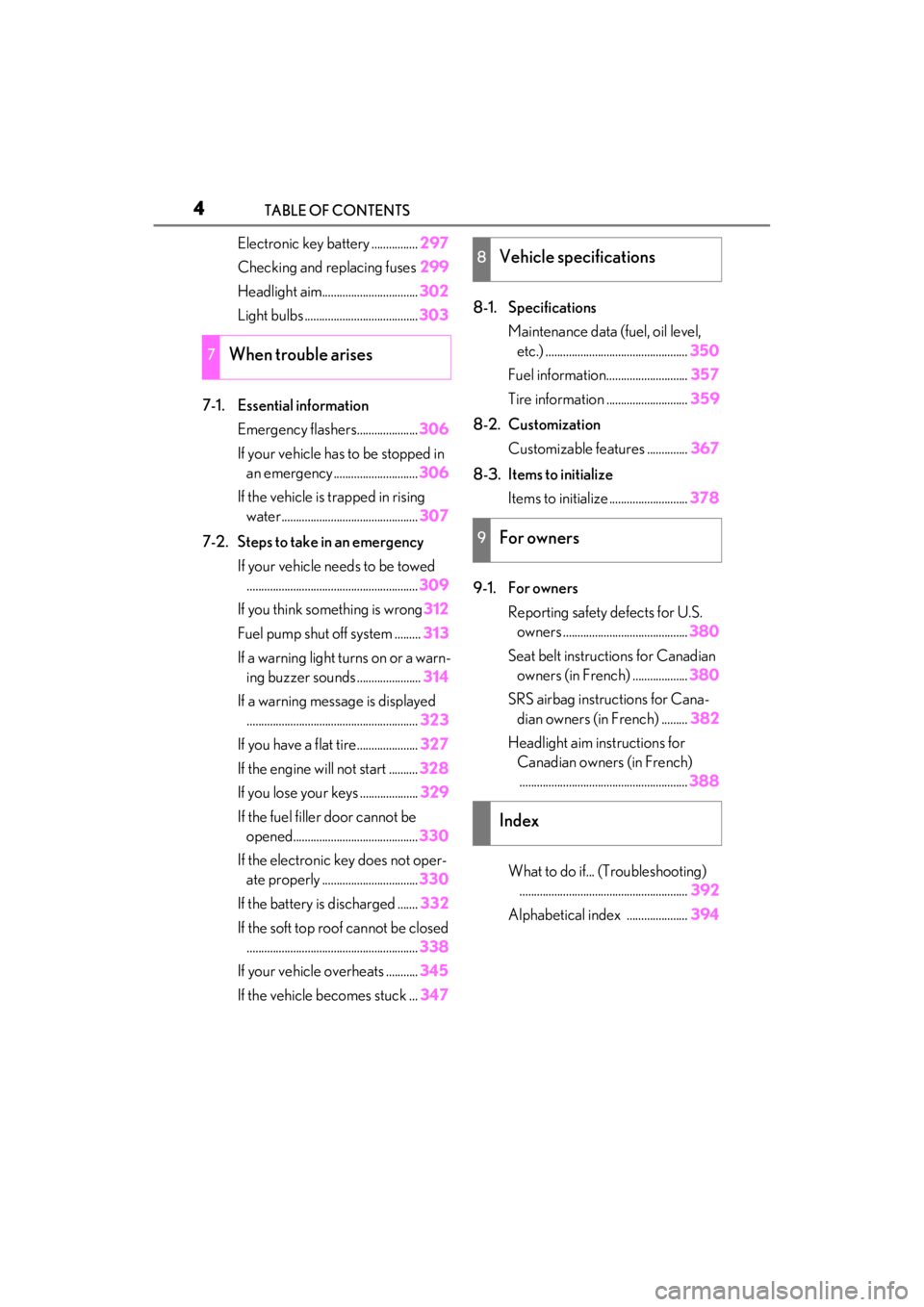
4TABLE OF CONTENTS
Electronic key battery ................297
Checking and replacing fuses 299
Headlight aim................................. 302
Light bulbs ....................................... 303
7-1. Essential information Emergency flashers..................... 306
If your vehicle has to be stopped in an emergency ............................. 306
If the vehicle is trapped in rising water............................................... 307
7-2. Steps to take in an emergency If your vehicle needs to be towed........................................................... 309
If you think something is wrong 312
Fuel pump shut off system ......... 313
If a warning light turns on or a warn- ing buzzer sounds ...................... 314
If a warning message is displayed ........................................................... 323
If you have a flat tire..................... 327
If the engine wi ll not start .......... 328
If you lose your keys .................... 329
If the fuel filler door cannot be opened........................................... 330
If the electronic key does not oper- ate properly ................................. 330
If the battery is discharged ....... 332
If the soft top roof cannot be closed ........................................................... 338
If your vehicle overheats ........... 345
If the vehicle becomes stuck ... 3478-1. Specifications
Maintenance data (fuel, oil level, etc.) ................................................. 350
Fuel information............................ 357
Tire information ............................ 359
8-2. Customization Customizable features .............. 367
8-3. Items to initialize Items to initialize ........................... 378
9-1. For owners Reporting safety defects for U.S. owners ........................................... 380
Seat belt instructions for Canadian owners (in French) ................... 380
SRS airbag instructions for Cana- dian owners (in French) ......... 382
Headlight aim instructions for Canadian owners (in French).......................................................... 388
What to do if... (Troubleshooting) .......................................................... 392
Alphabetical index ..................... 394
7When trouble arises
8Vehicle specifications
9For owners
Index
Page 13 of 410
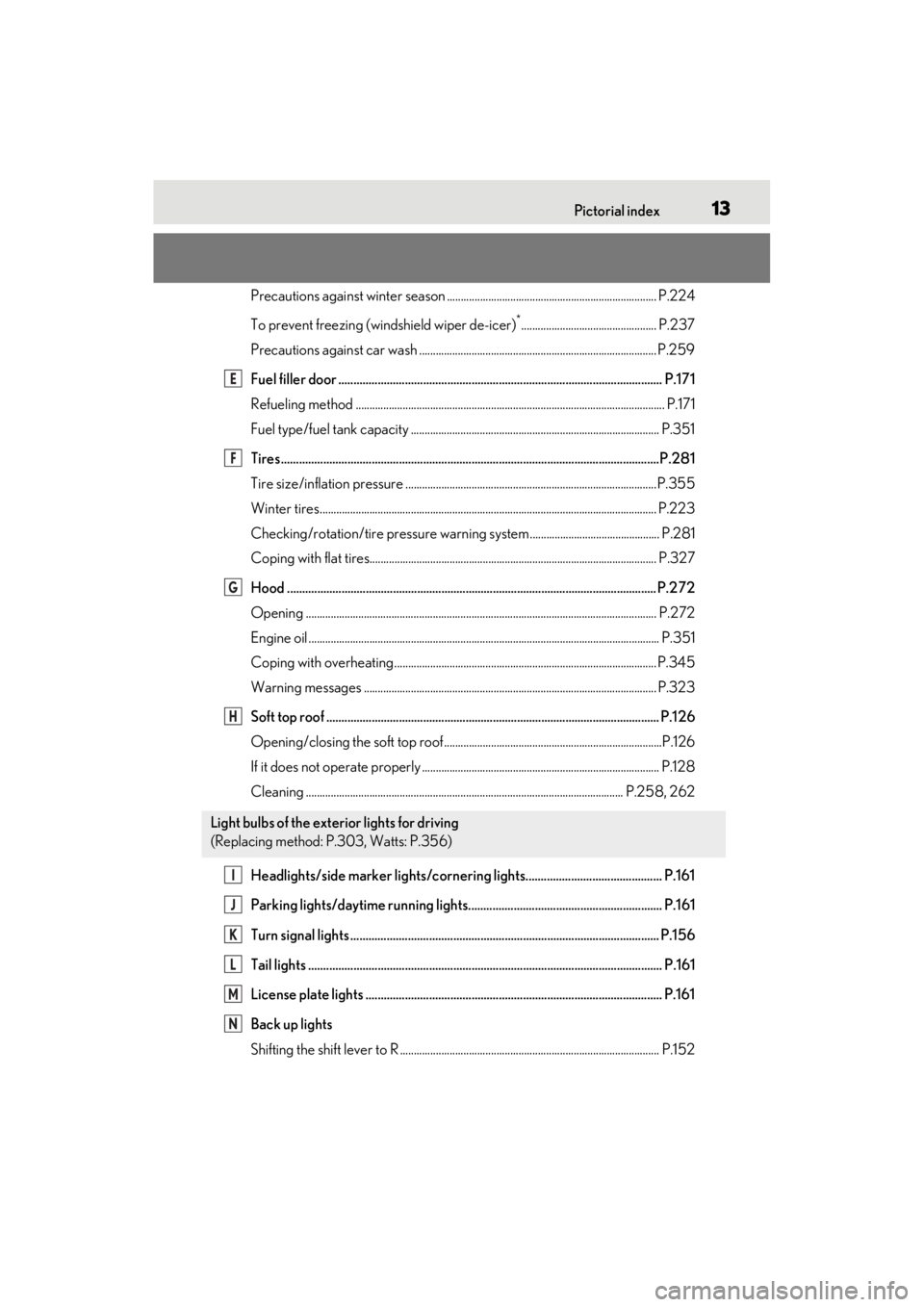
13Pictorial index
Precautions against winter season ............................................................................ P.224
To prevent freezing (windshield wiper de-icer)
*................................................. P.237
Precautions against car wash ............................. ......................................................... P.259
Fuel filler door ........................................................................................................... P.17 1
Refueling method ............................................................................................................... .P.171
Fuel type/fuel tank capacity ...... .................................................................................... P.351
Tires.......................................................................................................................... ...P.281
Tire size/inflation pressure ............................ ...............................................................P.355
Winter tires.......................................................................................................................... P.223
Checking/rotation/tire pressure warning system............................................... P.281
Coping with flat tires........................................................................................................ P .327
Hood .......................................................................................................................... P.272
Opening ........................................................................................................................ ....... P.272
Engine oil ..................................................................................................................... .......... P.351
Coping with overheating ............................................................................................... P.345
Warning messages .......................................................................................................... P.323
Soft top roof .............................................................................................................. P.12 6
Opening/closing the soft top roof...............................................................................P.126
If it does not operate properly ...................... ................................................................ P.128
Cleaning ................................................................................................................... P.25 8, 262
Headlights/side marker lights/cornering lights............................................. P.161
Parking lights/daytime running lights................................................................ P.161
Turn signal lights ...................................................................................................... P.156
Tail lights .................................................................................................................... .P.161
License plate lights .................................................................................................. P.161
Back up lights
Shifting the shift lever to R .............................................................................................. P.15 2
Light bulbs of the exterior lights for driving
(Replacing method: P.303, Watts: P.356)
E
F
G
H
I
J
K
L
M
N
Page 47 of 410
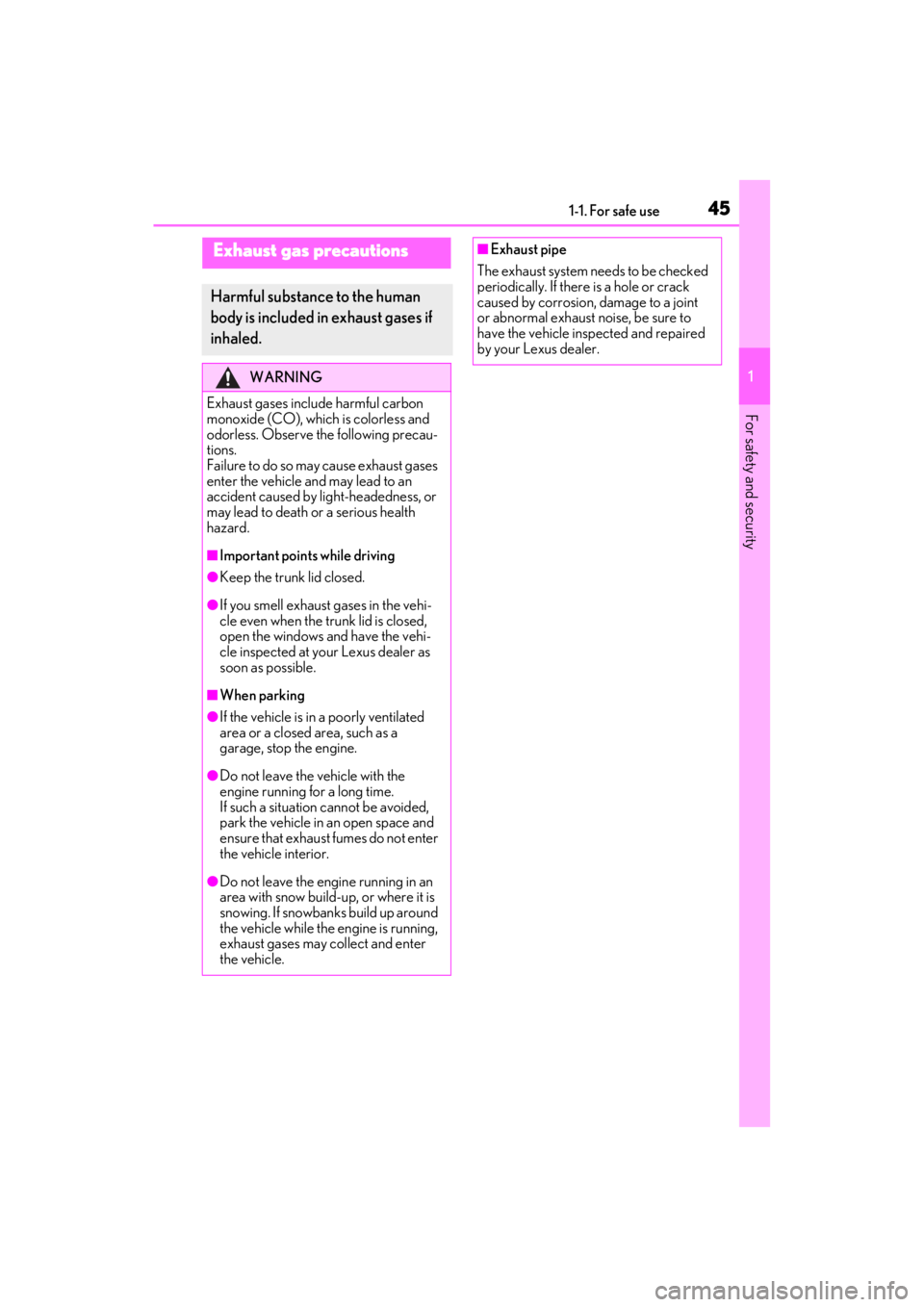
451-1. For safe use
1
For safety and security
Exhaust gas precautions
Harmful substance to the human
body is included in exhaust gases if
inhaled.
WARNING
Exhaust gases include harmful carbon
monoxide (CO), which is colorless and
odorless. Observe the following precau-
tions.
Failure to do so may cause exhaust gases
enter the vehicle and may lead to an
accident caused by light-headedness, or
may lead to death or a serious health
hazard.
■Important points while driving
●Keep the trunk lid closed.
●If you smell exhaust gases in the vehi-
cle even when the trunk lid is closed,
open the windows and have the vehi-
cle inspected at your Lexus dealer as
soon as possible.
■When parking
●If the vehicle is in a poorly ventilated
area or a closed area, such as a
garage, stop the engine.
●Do not leave the vehicle with the
engine running for a long time.
If such a situation cannot be avoided,
park the vehicle in an open space and
ensure that exhaust fumes do not enter
the vehicle interior.
●Do not leave the engine running in an
area with snow build-up, or where it is
snowing. If snowbanks build up around
the vehicle while the engine is running,
exhaust gases may collect and enter
the vehicle.
■Exhaust pipe
The exhaust system needs to be checked
periodically. If there is a hole or crack
caused by corrosion, damage to a joint
or abnormal exhaust noise, be sure to
have the vehicle inspected and repaired
by your Lexus dealer.
Page 67 of 410
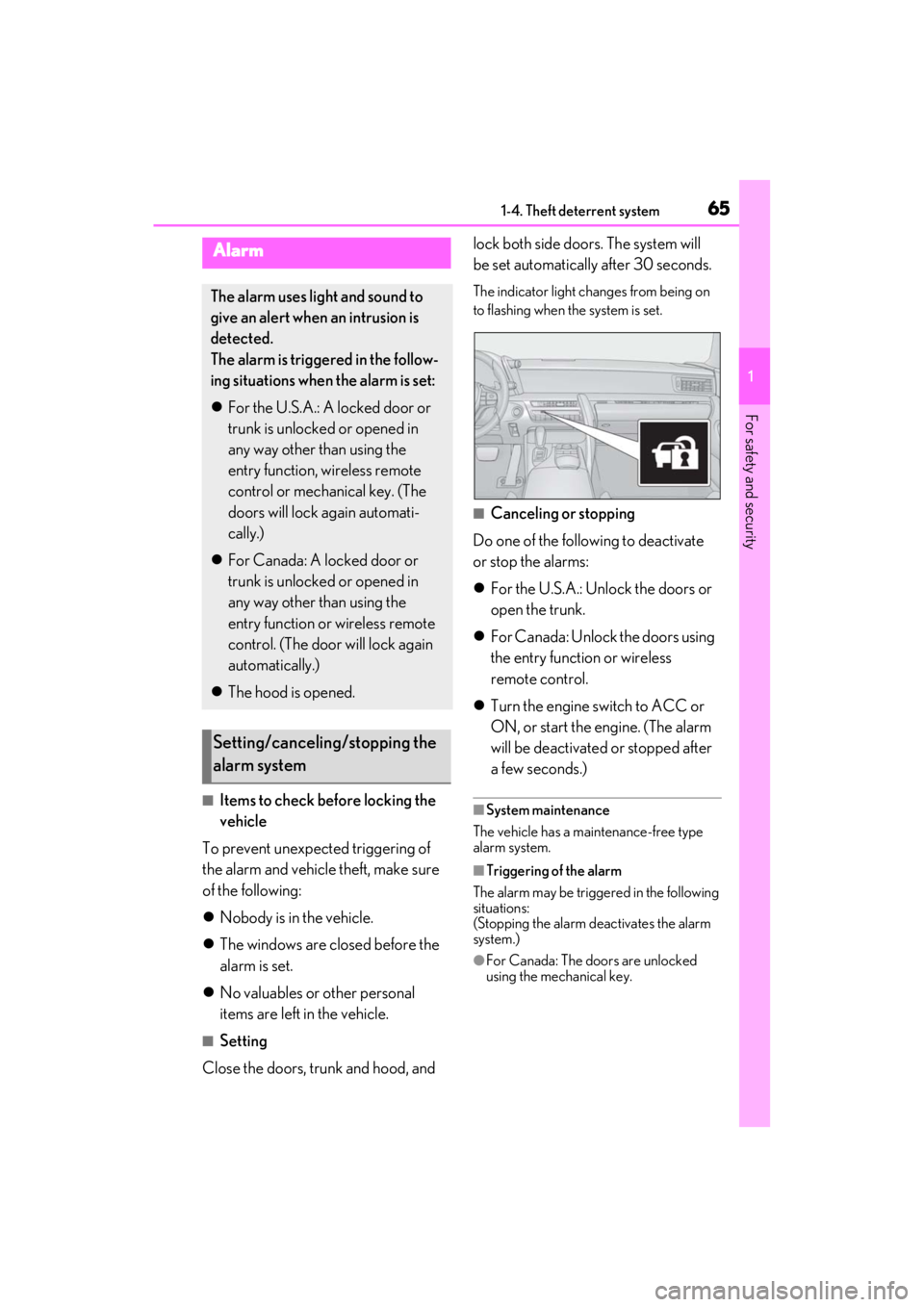
651-4. Theft deterrent system
1
For safety and security
■Items to check before locking the
vehicle
To prevent unexpected triggering of
the alarm and vehicle theft, make sure
of the following:
Nobody is in the vehicle.
The windows are closed before the
alarm is set.
No valuables or other personal
items are left in the vehicle.
■Setting
Close the doors, trunk and hood, and lock both side doors. The system will
be set automatically after 30 seconds.
The indicator light changes from being on
to flashing when the system is set.
■Canceling or stopping
Do one of the following to deactivate
or stop the alarms:
For the U.S.A.: Unlock the doors or
open the trunk.
For Canada: Unlock the doors using
the entry function or wireless
remote control.
Turn the engine switch to ACC or
ON, or start the engine. (The alarm
will be deactivated or stopped after
a few seconds.)
■System maintenance
The vehicle has a maintenance-free type
alarm system.
■Triggering of the alarm
The alarm may be triggered in the following
situations:
(Stopping the alarm deactivates the alarm
system.)
●For Canada: The doors are unlocked
using the mechanical key.
Alarm
The alarm uses light and sound to
give an alert when an intrusion is
detected.
The alarm is triggered in the follow-
ing situations when the alarm is set:
For the U.S.A.: A locked door or
trunk is unlocked or opened in
any way other than using the
entry function, wireless remote
control or mechanical key. (The
doors will lock again automati-
cally.)
For Canada: A locked door or
trunk is unlocked or opened in
any way other than using the
entry function or wireless remote
control. (The door will lock again
automatically.)
The hood is opened.
Setting/canceling/stopping the
alarm system
Page 73 of 410
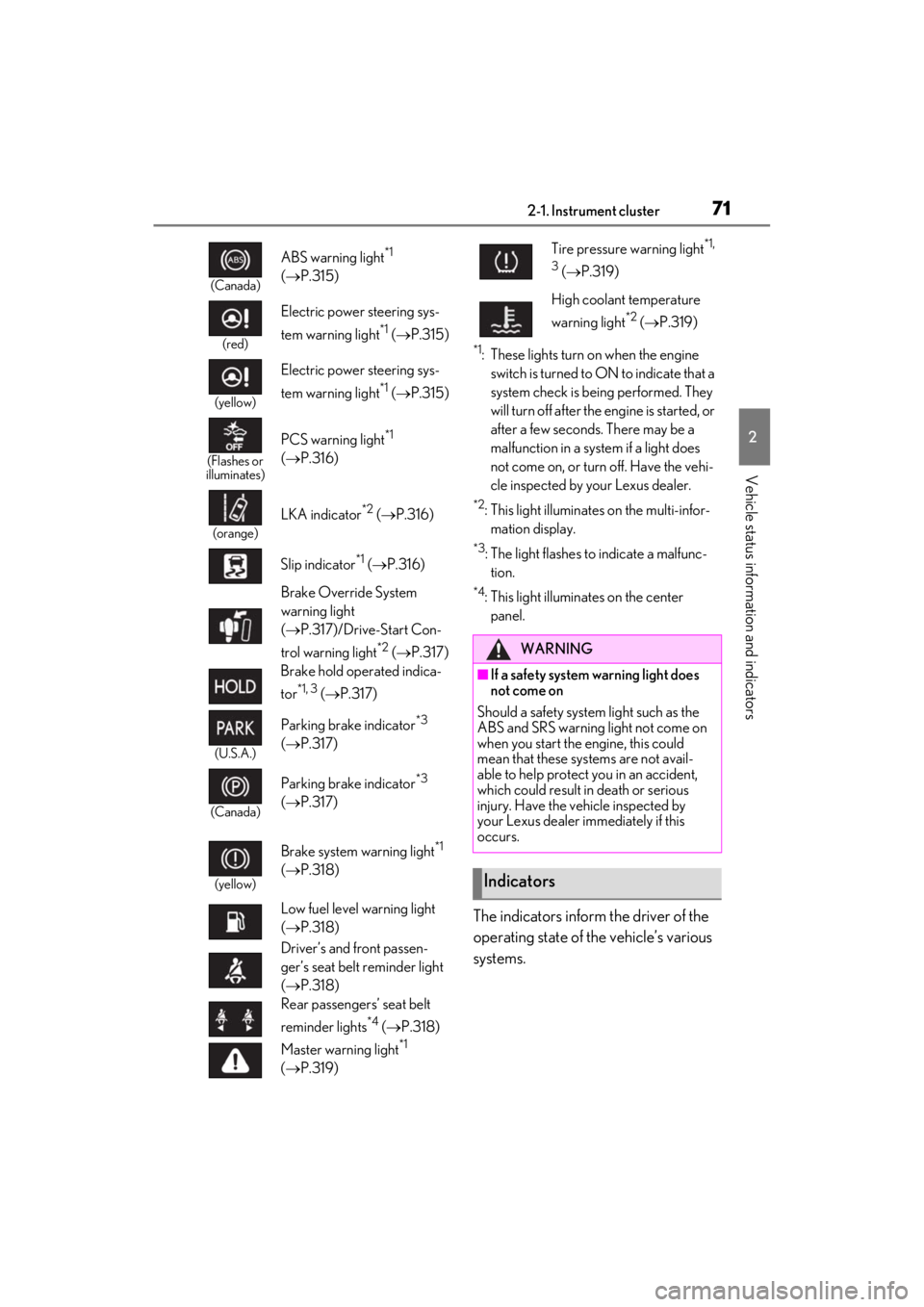
712-1. Instrument cluster
2
Vehicle status information and indicators
*1: These lights turn on when the engine switch is turned to ON to indicate that a
system check is being performed. They
will turn off after the engine is started, or
after a few seconds. There may be a
malfunction in a system if a light does
not come on, or turn off. Have the vehi-
cle inspected by your Lexus dealer.
*2: This light illuminates on the multi-infor- mation display.
*3: The light flashes to indicate a malfunc-tion.
*4: This light illuminates on the center panel.
The indicators inform the driver of the
operating state of the vehicle’s various
systems.
(Canada)
ABS warning light*1
( P.315)
(red)
Electric power steering sys-
tem warning light
*1 ( P.315)
(yellow)
Electric power steering sys-
tem warning light
*1 ( P.315)
(Flashes or
illuminates)
PCS warning light*1
( P.316)
(orange)
LKA indicator*2 ( P.316)
Slip indicator
*1 ( P.316)
Brake Override System
warning light
( P.317)/Drive-Start Con-
trol warning light
*2 ( P.317)
Brake hold operated indica-
tor
*1, 3 ( P.317)
(U.S.A.)
Parking brake indicator*3
( P.317)
(Canada)
Parking brake indicator*3
( P.317)
(yellow)
Brake system warning light*1
( P.318)
Low fuel level warning light
( P.318)
Driver’s and front passen-
ger’s seat belt reminder light
( P.318)
Rear passengers’ seat belt
reminder lights
*4 ( P.318)
Master warning light
*1
( P.319)
Tire pressure warning light*1,
3
( P.319)
High coolant temperature
warning light
*2 ( P.319)
WARNING
■If a safety system warning light does
not come on
Should a safety system light such as the
ABS and SRS warning light not come on
when you start the engine, this could
mean that these systems are not avail-
able to help protect you in an accident,
which could result in death or serious
injury. Have the vehicle inspected by
your Lexus dealer immediately if this
occurs.
Indicators
Page 75 of 410
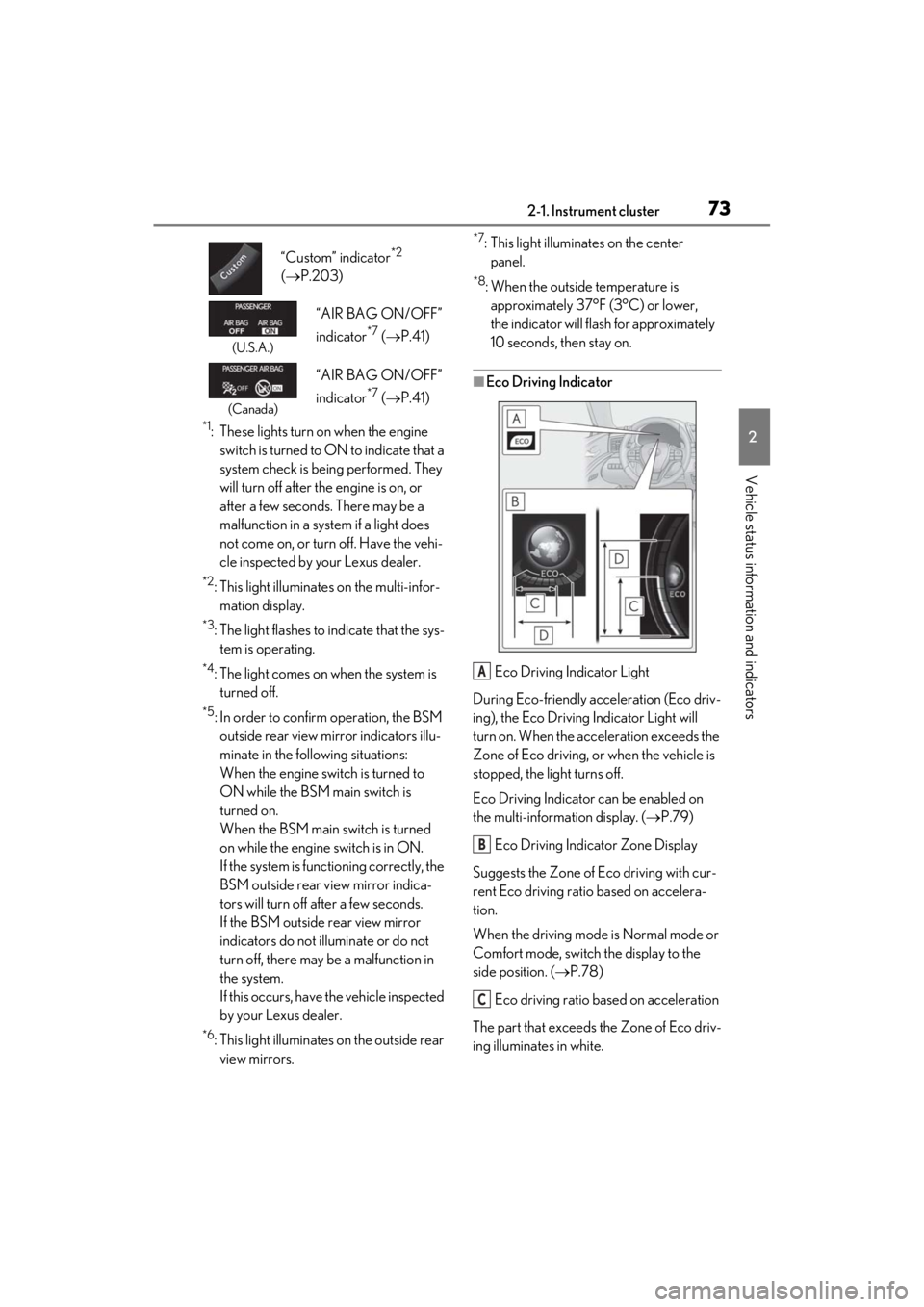
732-1. Instrument cluster
2
Vehicle status information and indicators
*1: These lights turn on when the engine switch is turned to ON to indicate that a
system check is being performed. They
will turn off after th e engine is on, or
after a few seconds. There may be a
malfunction in a system if a light does
not come on, or turn off. Have the vehi-
cle inspected by your Lexus dealer.
*2: This light illuminates on the multi-infor- mation display.
*3: The light flashes to indicate that the sys-tem is operating.
*4: The light comes on when the system is turned off.
*5: In order to confirm operation, the BSM outside rear view mirror indicators illu-
minate in the following situations:
When the engine switch is turned to
ON while the BSM main switch is
turned on.
When the BSM main switch is turned
on while the engine switch is in ON.
If the system is functioning correctly, the
BSM outside rear view mirror indica-
tors will turn off after a few seconds.
If the BSM outside rear view mirror
indicators do not illuminate or do not
turn off, there may be a malfunction in
the system.
If this occurs, have the vehicle inspected
by your Lexus dealer.
*6: This light illuminates on the outside rear view mirrors.
*7: This light illuminates on the center panel.
*8: When the outside temperature is approximately 37°F (3°C) or lower,
the indicator will flash for approximately
10 seconds, then stay on.
■Eco Driving Indicator
Eco Driving Indicator Light
During Eco-friendly acceleration (Eco driv-
ing), the Eco Driving Indicator Light will
turn on. When the acceleration exceeds the
Zone of Eco driving, or when the vehicle is
stopped, the light turns off.
Eco Driving Indicator can be enabled on
the multi-information display. ( P.79)
Eco Driving Indicator Zone Display
Suggests the Zone of Eco driving with cur-
rent Eco driving ratio based on accelera-
tion.
When the driving mode is Normal mode or
Comfort mode, switch the display to the
side position. ( P.78)
Eco driving ratio based on acceleration
The part that exceeds the Zone of Eco driv-
ing illuminates in white.
“Custom” indicator
*2
( P.203)
(U.S.A.)
“AIR BAG ON/OFF”
indicator
*7 ( P.41)
(Canada)
“AIR BAG ON/OFF”
indicator
*7 ( P.41)
A
B
C
Page 79 of 410
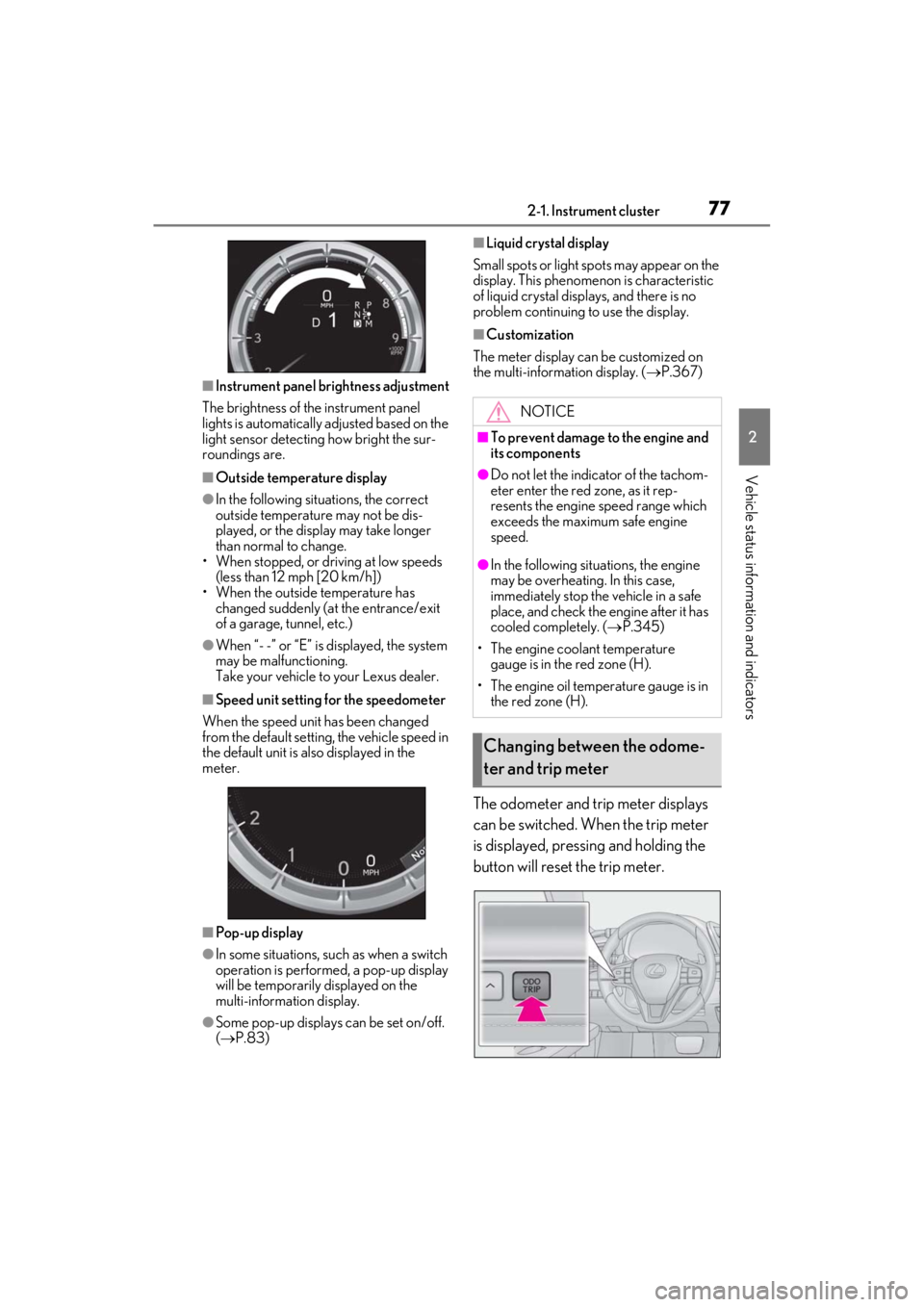
772-1. Instrument cluster
2
Vehicle status information and indicators
■Instrument panel brightness adjustment
The brightness of the instrument panel
lights is automatically adjusted based on the
light sensor detecting how bright the sur-
roundings are.
■Outside temperature display
●In the following situations, the correct
outside temperature may not be dis-
played, or the display may take longer
than normal to change.
• When stopped, or driving at low speeds
(less than 12 mph [20 km/h])
• When the outside temperature has changed suddenly (at the entrance/exit
of a garage, tunnel, etc.)
●When “- -” or “E” is displayed, the system
may be malfunctioning.
Take your vehicle to your Lexus dealer.
■Speed unit setting for the speedometer
When the speed unit has been changed
from the default setting, the vehicle speed in
the default unit is also displayed in the
meter.
■Pop-up display
●In some situations, su ch as when a switch
operation is performed, a pop-up display
will be temporarily displayed on the
multi-information display.
●Some pop-up displays can be set on/off.
( P.83)
■Liquid crystal display
Small spots or light spots may appear on the
display. This phenomen on is characteristic
of liquid crystal disp lays, and there is no
problem continuing to use the display.
■Customization
The meter display can be customized on
the multi-information display. ( P.367)
The odometer and trip meter displays
can be switched. When the trip meter
is displayed, pressing and holding the
button will reset the trip meter.
NOTICE
■To prevent damage to the engine and
its components
●Do not let the indicator of the tachom-
eter enter the red zone, as it rep-
resents the engine speed range which
exceeds the maximum safe engine
speed.
●In the following situations, the engine
may be overheating. In this case,
immediately stop the vehicle in a safe
place, and check the engine after it has
cooled completely. ( P.345)
• The engine coolant temperature gauge is in the red zone (H).
• The engine oil temperature gauge is in the red zone (H).
Changing between the odome-
ter and trip meter
Page 115 of 410
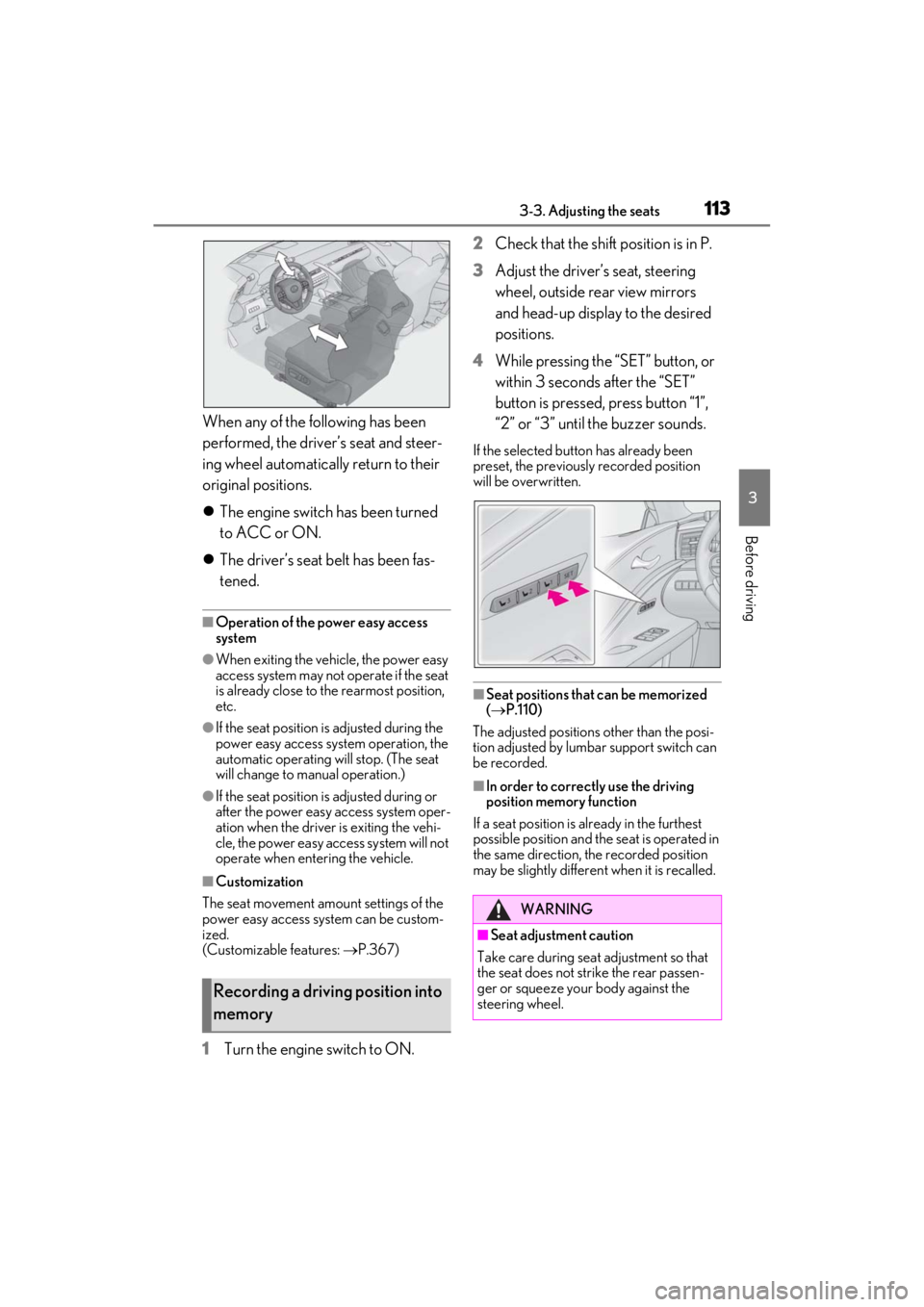
1133-3. Adjusting the seats
3
Before driving
When any of the following has been
performed, the driver’s seat and steer-
ing wheel automatically return to their
original positions.
The engine switch has been turned
to ACC or ON.
The driver’s seat belt has been fas-
tened.
■Operation of the power easy access
system
●When exiting the vehicle, the power easy
access system may not operate if the seat
is already close to the rearmost position,
etc.
●If the seat position is adjusted during the
power easy access sy stem operation, the
automatic operating will stop. (The seat
will change to manual operation.)
●If the seat position is adjusted during or
after the power easy access system oper-
ation when the driver is exiting the vehi-
cle, the power easy access system will not
operate when entering the vehicle.
■Customization
The seat movement amou nt settings of the
power easy access sy stem can be custom-
ized.
(Customizable features: P.367)
1Turn the engine switch to ON. 2
Check that the shift position is in P.
3
Adjust the driver’s seat, steering
wheel, outside rear view mirrors
and head-up display to the desired
positions.
4
While pressing the “SET” button, or
within 3 seconds after the “SET”
button is pressed, press button “1”,
“2” or “3” until the buzzer sounds.
If the selected button has already been
preset, the previously recorded position
will be overwritten.
■Seat positions that can be memorized
( P.110)
The adjusted positions other than the posi-
tion adjusted by lumbar support switch can
be recorded.
■In order to correctly use the driving
position memory function
If a seat position is already in the furthest
possible position and the seat is operated in
the same direction, the recorded position
may be slightly differen t when it is recalled.
Recording a driving position into
memory
WARNING
■Seat adjustment caution
Take care during seat adjustment so that
the seat does not strike the rear passen-
ger or squeeze your body against the
steering wheel.
Page 140 of 410
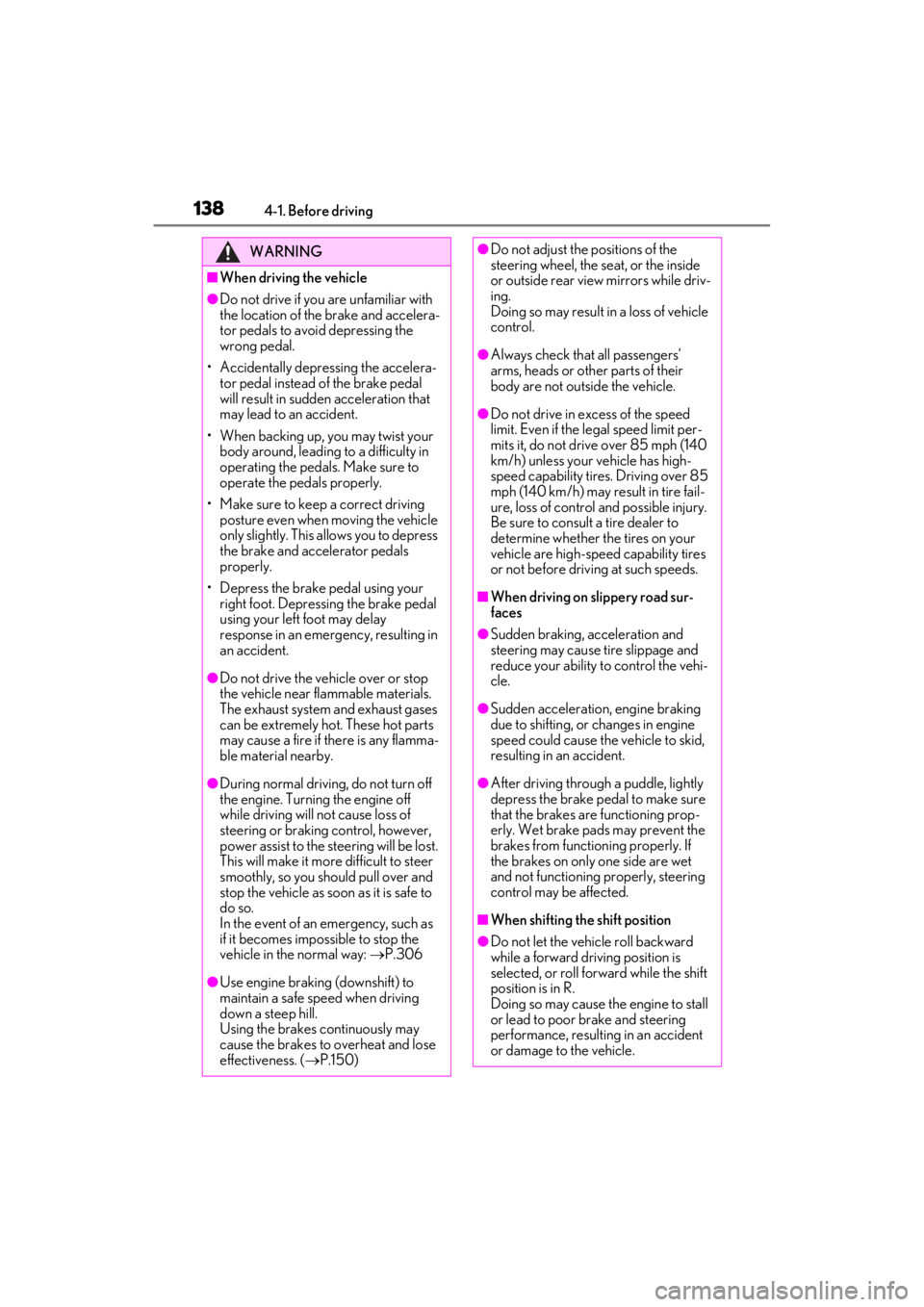
1384-1. Before driving
WARNING
■When driving the vehicle
●Do not drive if you are unfamiliar with
the location of the brake and accelera-
tor pedals to avoid depressing the
wrong pedal.
• Accidentally depressing the accelera- tor pedal instead of the brake pedal
will result in sudden acceleration that
may lead to an accident.
• When backing up, you may twist your body around, leading to a difficulty in
operating the pedals. Make sure to
operate the pedals properly.
• Make sure to keep a correct driving posture even when moving the vehicle
only slightly. This allows you to depress
the brake and accelerator pedals
properly.
• Depress the brake pedal using your right foot. Depressing the brake pedal
using your left foot may delay
response in an emergency, resulting in
an accident.
●Do not drive the vehicle over or stop
the vehicle near flammable materials.
The exhaust system and exhaust gases
can be extremely hot. These hot parts
may cause a fire if there is any flamma-
ble material nearby.
●During normal driving, do not turn off
the engine. Turning the engine off
while driving will not cause loss of
steering or braking control, however,
power assist to the steering will be lost.
This will make it more difficult to steer
smoothly, so you should pull over and
stop the vehicle as soon as it is safe to
do so.
In the event of an emergency, such as
if it becomes impo ssible to stop the
vehicle in the normal way: P.306
●Use engine braking (downshift) to
maintain a safe speed when driving
down a steep hill.
Using the brakes continuously may
cause the brakes to overheat and lose
effectiveness. ( P.150)
●Do not adjust the positions of the
steering wheel, the seat, or the inside
or outside rear view mirrors while driv-
ing.
Doing so may result in a loss of vehicle
control.
●Always check that all passengers’
arms, heads or other parts of their
body are not outside the vehicle.
●Do not drive in excess of the speed
limit. Even if the legal speed limit per-
mits it, do not drive over 85 mph (140
km/h) unless your vehicle has high-
speed capability tires. Driving over 85
mph (140 km/h) may result in tire fail-
ure, loss of control and possible injury.
Be sure to consult a tire dealer to
determine whether the tires on your
vehicle are high-speed capability tires
or not before driving at such speeds.
■When driving on slippery road sur-
faces
●Sudden braking, acceleration and
steering may cause tire slippage and
reduce your ability to control the vehi-
cle.
●Sudden acceleration, engine braking
due to shifting, or changes in engine
speed could cause the vehicle to skid,
resulting in an accident.
●After driving through a puddle, lightly
depress the brake pedal to make sure
that the brakes are functioning prop-
erly. Wet brake pads may prevent the
brakes from functioning properly. If
the brakes on only one side are wet
and not functioning properly, steering
control may be affected.
■When shifting the shift position
●Do not let the vehicle roll backward
while a forward driving position is
selected, or roll forw ard while the shift
position is in R.
Doing so may cause the engine to stall
or lead to poor brake and steering
performance, resulting in an accident
or damage to the vehicle.
Page 141 of 410
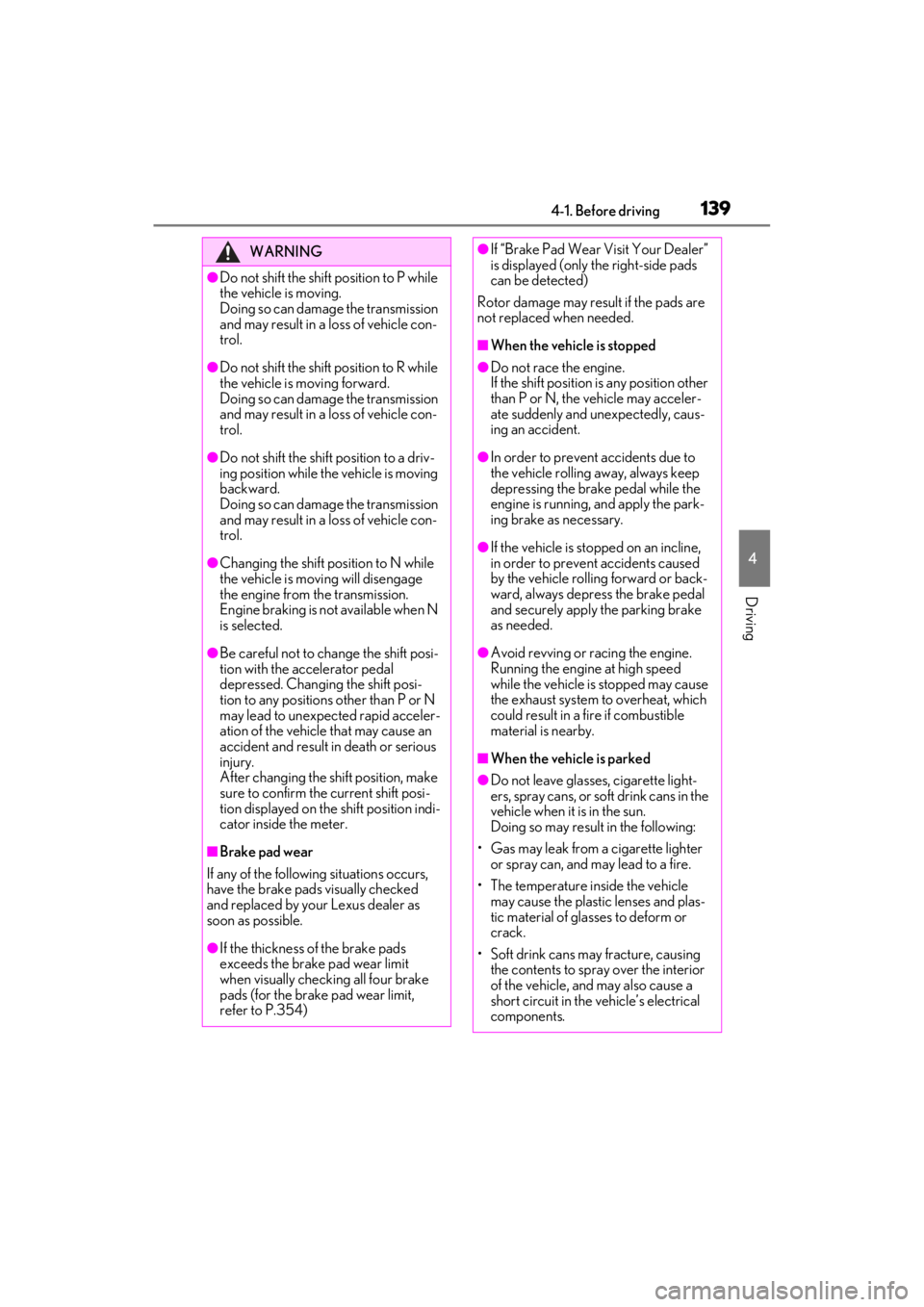
1394-1. Before driving
4
Driving
WARNING
●Do not shift the shift position to P while
the vehicle is moving.
Doing so can damage the transmission
and may result in a loss of vehicle con-
trol.
●Do not shift the shift position to R while
the vehicle is moving forward.
Doing so can damage the transmission
and may result in a loss of vehicle con-
trol.
●Do not shift the shift position to a driv-
ing position while the vehicle is moving
backward.
Doing so can damage the transmission
and may result in a loss of vehicle con-
trol.
●Changing the shift position to N while
the vehicle is moving will disengage
the engine from the transmission.
Engine braking is not available when N
is selected.
●Be careful not to change the shift posi-
tion with the accelerator pedal
depressed. Changing the shift posi-
tion to any positions other than P or N
may lead to unexpected rapid acceler-
ation of the vehicle that may cause an
accident and result in death or serious
injury.
After changing the shift position, make
sure to confirm the current shift posi-
tion displayed on the shift position indi-
cator inside the meter.
■Brake pad wear
If any of the following situations occurs,
have the brake pads visually checked
and replaced by your Lexus dealer as
soon as possible.
●If the thickness of the brake pads
exceeds the brake pad wear limit
when visually checking all four brake
pads (for the brake pad wear limit,
refer to P.354)
●If “Brake Pad Wear Visit Your Dealer”
is displayed (only the right-side pads
can be detected)
Rotor damage may result if the pads are
not replaced when needed.
■When the vehicle is stopped
●Do not race the engine.
If the shift position is any position other
than P or N, the vehicle may acceler-
ate suddenly and unexpectedly, caus-
ing an accident.
●In order to prevent accidents due to
the vehicle rolling away, always keep
depressing the brake pedal while the
engine is running, and apply the park-
ing brake as necessary.
●If the vehicle is stopped on an incline,
in order to prevent accidents caused
by the vehicle rolling forward or back-
ward, always depress the brake pedal
and securely apply the parking brake
as needed.
●Avoid revving or racing the engine.
Running the engine at high speed
while the vehicle is stopped may cause
the exhaust system to overheat, which
could result in a fire if combustible
material is nearby.
■When the vehicle is parked
●Do not leave glasses, cigarette light-
ers, spray cans, or soft drink cans in the
vehicle when it is in the sun.
Doing so may result in the following:
• Gas may leak from a cigarette lighter or spray can, and may lead to a fire.
• The temperature inside the vehicle may cause the plastic lenses and plas-
tic material of glasses to deform or
crack.
• Soft drink cans may fracture, causing the contents to spray over the interior
of the vehicle, and may also cause a
short circuit in the vehicle’s electrical
components.